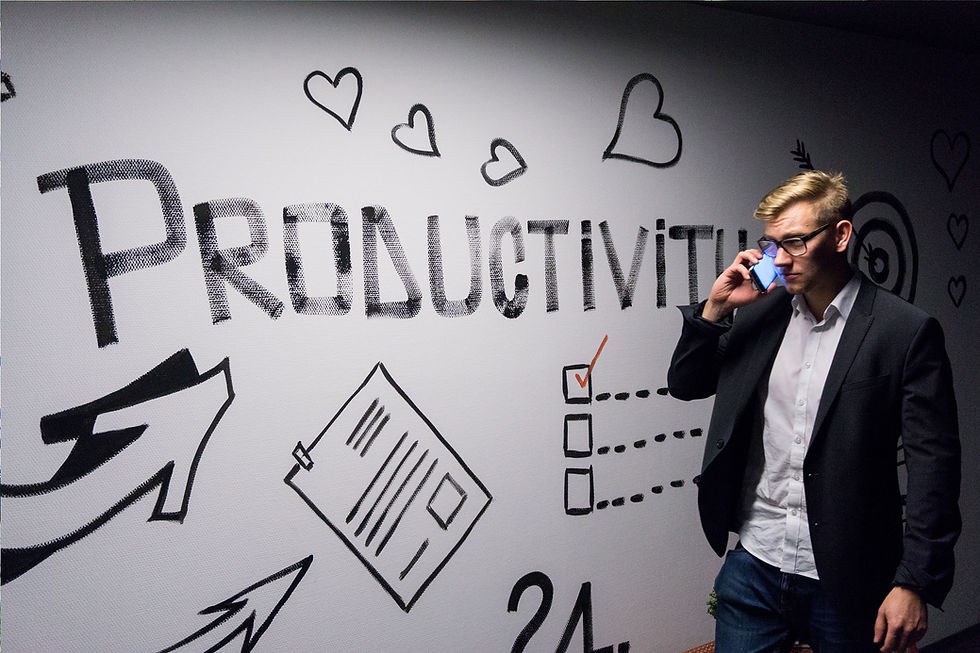The AI Productivity Toolkit: How Smart Organisations Are Transforming Work in 2025
- elixion solutions
- Aug 19
- 5 min read

The workplace productivity revolution is here, and it's powered by AI. While organisations have been experimenting with artificial intelligence for years, 2025 marks the tipping point where AI productivity tools have moved from novelty to necessity. 28% of all workers used generative AI at work to some degree, and the results are staggering: Staff using AI report an 80% improvement in productivity due to the technology.
But here's the reality check: Almost all companies invest in AI, but just 1% believe they are at maturity. The gap between AI adoption and AI mastery is where competitive advantage lies. Smart organisations aren't just using AI tools - they're strategically orchestrating them to transform how work gets done.
The New AI Productivity Stack
The modern workplace is being reshaped by a powerful combination of specialised AI tools, each excelling in different aspects of productivity. Understanding how to leverage these tools effectively has become a core competitive skill.
Research and Information Synthesis: The Perplexity Advantage
Perplexity has emerged as the go-to tool for professionals who need fast, accurate research capabilities. Perplexity excels at ultra-fast, concise search-style answers, making it invaluable for market research, competitive analysis, and rapid fact-checking. Unlike traditional search engines that return links, Perplexity provides synthesised answers with proper citations, dramatically reducing research time.
Organisations using Perplexity for research tasks report cutting research time by 60-70%, allowing teams to spend more time on analysis and decision-making rather than information gathering. This is particularly powerful for consultants, analysts, and strategic planners who need to quickly understand complex topics or market conditions.
Content Creation and Complex Reasoning: The Claude Ecosystem
Claude has positioned itself as the thinking partner for complex work. Anthropic's safe and creative chatbot, Claude builds Artifacts: it can code simple interactive interfaces, write documents in a separate tab, or even design games for you. Claude offers structured, in-depth responses and built-in image and code generation across all plans.
What sets Claude apart is its ability to handle nuanced, multi-step reasoning tasks. Organisations use Claude for strategic planning, complex document creation, policy development, and detailed analysis that requires understanding context and implications beyond surface-level information.
The Power of AI Orchestration
The most sophisticated organisations don't rely on single AI tools - they create AI workflows that leverage multiple specialised systems. The true power of these AI productivity tools lies in their ability to complement each other. Perplexity excels at gathering accurate, real-time data, while Claude processes this information into actionable insights, creative outputs, and tailored deliverables.
This orchestration approach allows teams to:
Use Perplexity for rapid research and data gathering
Process findings through Claude for deep analysis and strategic insights
Generate polished deliverables with specialised formatting tools
Iterate quickly on complex projects with multiple AI touchpoints
Measurable Business Impact
The productivity gains from strategic AI tool adoption are substantial and measurable. 20% to 30% gains in productivity, speed to market and revenue are becoming standard expectations for organisations that implement AI tools effectively.
Real-world examples demonstrate this impact:
Insight Enterprises employees using Copilot gain four hours of productivity per week through data summarisation and content creation
51% of SMBs that have adopted Generative AI reported a revenue increase of 10% or more from their efforts
One company experienced a 30% growth in customer satisfaction after shifting to AI tools
These aren't just efficiency improvements - they represent fundamental changes in how organisations create value and serve customers.
The Strategic Implementation Framework
1. Identify High-Impact Use Cases
Start with tasks that are time-intensive but don't require deep institutional knowledge. Content creation, research synthesis, data analysis, and document preparation are ideal starting points. These tasks offer immediate productivity gains while allowing teams to build AI proficiency.
2. Build AI Fluency Across Teams
79% of leaders agree their company needs to adopt AI to stay competitive, but 59% worry about quantifying the productivity gains of AI. This uncertainty often stems from lack of hands-on experience with AI tools.
Invest in practical AI training that goes beyond theoretical understanding. Teams need hands-on experience with tools like Perplexity for research, Claude for analysis, and other specialised AI applications relevant to their roles.
3. Create AI-Native Workflows
Don't just add AI to existing processes - redesign workflows around AI capabilities. This might mean restructuring research processes to leverage Perplexity's real-time synthesis, or redesigning content creation workflows to take advantage of Claude's iterative capabilities.
4. Measure and Optimise
Track specific productivity metrics: time saved on research, quality improvements in deliverables, faster project completion rates, and customer satisfaction improvements. These measurements help justify AI investments and guide optimisation efforts.
Industry-Specific Applications
Professional Services
Consultants and advisors use AI research tools to rapidly understand client industries, synthesise market conditions, and develop strategic recommendations. The combination of Perplexity for research and Claude for analysis allows consultants to deliver higher-quality insights faster.
Marketing and Communications
Marketing teams leverage AI tools for market research, content creation, competitive analysis, and campaign optimisation. AI enables smaller teams to compete with larger organisations by amplifying their creative and analytical capabilities.
Finance and Analysis
Financial professionals use AI for market research, regulatory compliance research, financial modelling support, and client communication. AI tools help analysts focus on interpretation and strategy rather than data gathering and basic analysis.
Human Resources
HR teams utilise AI for policy development, employee communication, training material creation, and market compensation analysis. This allows HR professionals to spend more time on strategic initiatives and employee development.
Overcoming Implementation Challenges
The Maturity Gap Challenge
60% of leaders worry their organisation's leadership lacks a plan and vision to implement AI. Success requires clear leadership commitment and strategic vision, not just tool procurement.
Develop a clear AI adoption roadmap that includes:
Specific use cases and expected outcomes
Training and support resources
Success metrics and measurement frameworks
Governance policies for AI tool usage
Integration and Workflow Design
AI tools are most effective when integrated into existing workflows rather than treated as standalone solutions. This requires careful planning and often workflow redesign to maximise AI benefits.
Quality Control and Governance
Establish clear guidelines for AI tool usage, including fact-checking requirements, quality standards, and appropriate use cases. This ensures AI enhances rather than compromises work quality.
The Future of AI-Powered Productivity
We're witnessing the early stages of a fundamental shift in how knowledge work gets done. 71 percent of respondents say their organisations regularly use gen AI in at least one business function, up from 65 percent in early 2024. This rapid adoption curve suggests that AI fluency will soon become a baseline requirement for competitive organisations.
The organisations that master AI productivity tools now will have significant advantages as these technologies continue evolving. They'll have developed the workflows, training systems, and cultural adaptations necessary to leverage increasingly sophisticated AI capabilities.
Building Your AI Productivity Strategy
The question isn't whether to adopt AI productivity tools - it's how quickly and effectively your organisation can integrate them into core workflows. Start with high-impact, low-risk applications, build team fluency through hands-on experience, and gradually expand AI usage as competency grows.
The productivity advantages are real and measurable. The tools are mature and accessible. The competitive pressure is mounting. The only question remaining is whether your organisation will lead this transformation or follow others who moved faster.
Taking Action
Begin with a pilot program focused on specific, measurable productivity improvements. Choose tools like Perplexity for research-intensive roles and Claude for analysis and content creation. Track metrics rigorously, gather team feedback, and iterate on workflows based on real usage patterns.
The AI productivity revolution isn't coming - it's here. The organisations that recognise this and act decisively will build sustainable competitive advantages through enhanced human capability and dramatically improved operational efficiency.
The future belongs to organisations that can think faster, research more thoroughly, and create higher-quality work than their competitors. AI productivity tools make this future achievable today.
Ready to transform your organisation's productivity with AI tools? Our team specialises in designing AI adoption frameworks that deliver measurable results while building long-term competitive advantages.




Comments